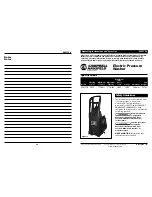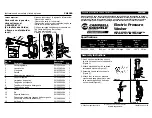
7
Maintenance
De-liming Coils
Periodic flushing of coils or optional float tank is
recommended.
Step 1:
Fill a container with 4 gallons of water, then add
1 lb. of de-liming powder. Mix thoroughly. Pour mixture
into float tank.
Step 2:
Remove wand assembly from spray gun and
put spray gun into float tank. Secure the trigger on the
spray gun into the open position.
Step 3:
Turn engine on, allowing solution to be pumped
through coils back into the float tank. The solution
should be allowed to circulate 2-4 hours or until the
color changes.
Step 4:
After circulating solution, flush the entire sys-
tem with fresh water. Clean out float tank and then
reinstall wand assembly to spray gun.
Removal of Soot and Heating Coil
In the heating process, fuel residue in the form of soot
deposits may develop between the heating coil pipe
and block air flow which will affect burner combustion.
When soot has been detected on visual observation,
the soot on the coil must be washed off after following
the coil removal steps (See Coil).
Rupture Disk
If pressure from pump or thermal expansion should
exceed safe limits, the rupture disk will burst allowing
high pressure to be discharged through hose to ground.
When disk ruptures it will need to be replaced.he
Rupture Disk should be replaced every two years.
Fuel
CAUTION: Use Ultra Low Sulfur Fuel only.
ATTENTION: Utiliser du carburant à faible teneur
en soufre seulement.
Diesel fuel must be clean, fresh, meet fuel specifica-
tions and be sourced from a known and reputable
supplier. Clean, fresh and properly specified diesel fuel
will provide assurances of maximum engine perfor-
mance and maximum fuel injection system longevity.
The use of out-of-spec, dirty or questionable quality
diesel fuel will result in engine performance and start
ability problems as well as reductions in engine and fuel
injection system life.
Use clean fuel oil that is not contaminated with water
and debris. Replace fuel filter and drain tank every 100
hours of operation.
Fuel Control System
This machine utilizes a fuel solenoid valve located on
the fuel pump to control the flow of fuel to the combus-
tion chamber. The solenoid, which is normally closed, is
activated by a flow switch when water flows through it.
When the operator releases the trigger on the spray
gun, the flow of water through the flow switch stops,
turning off the electrical current to the fuel solenoid.
The solenoid then closes, shutting off the supply of fuel
to the combustion chamber. Controlling the flow of fuel
in this way gives an instantaneous burn-or-no-burn situ-
ation, thereby eliminating high and low water tempera-
tures and the combustion smoke normally associated
with machines incorporating a spray gun. Periodic
inspection, to insure that the fuel solenoid valve
functions properly, is recommended. This can be done
by operating the machine and checking to see that the
burner is not firing when the spray gun is in the OFF
position.
Fuel Pressure Adjustment
To adjust fuel pressure, First install a pressure gage
into the port just after the pump fuel exit. Turn the
adjusting screw (located at the regulator port)
clockwise to increase, and counterclockwise to
decrease. Do not exceed 200 psi or lower the pressure
below 130 PSI, when checked at the post-pump
pressure port.
The fuel pressure may need to be adjusted due to
altitude. For every 500 ft altitude above sea level, the
boiling point of water goes down 1 °F. At high altitude
environments, this boiling point change may require the
heat input to be lowered so the water input does not
turn to steam earlier than at the factory settings and
activate the pressure sensors and pressure relief
equipment when the unit is operated and much higher
altitudes from factory settings or local dealer site
settings. Check with your dealer before making local
site fuel pressure adjustments.
Also, as ambient temperature changes seasonally, the
fuel temperature in the feed tank and air temperature
inlet can impact fuel flow. In more extreme tempera-
tures, this local-site adjustment may also require
different fuel nozzles for fuel inlet temperatures that are
at seasonal extremes (higher or lower) in locations
where the temperature changes are beyond moderate
temperatures of between 40°F and 90°F. Colder
temperatures will make for a thicker flow and less fine a
fuel spray while hotter temperatures will make for a
thinner flow a more fine spray with the same nozzle.
Consider alternate nozzle configurations from the
Landa PDHW Service Manual 8.920-098.0 - AU
Summary of Contents for 1.110-060.0
Page 2: ...2 Landa PDHW Service Manual 8 920 098 0 AU Machine Data Label...
Page 14: ...14 Notes Landa PDHW Service Manual 8 920 098 0 AU...
Page 34: ...34 Wayne Burner EHASR DC Landa PDHW Service Manual 8 920 098 0 AU...
Page 36: ...36 Wayne Burner EHASR AC Landa PDHW Service Manual 8 920 098 0 AU...
Page 43: ...43 Landa PDHW Service Manual 8 920 098 0 AU Notes...
Page 44: ...8 920 098 0 Printed in U S A...








































